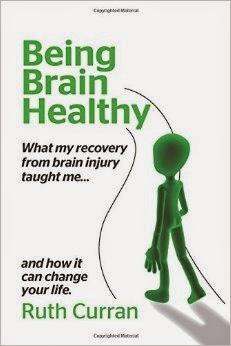
Published 11 March 2015.
Working on brain health is vital to every person, not just for those coming back from a traumatic brain injury (TBI).Curran's Background
However, it was her own experience sustaining a brain injury in a car accident in November of 2003 that started Ruth Curran on her quest for greater knowledge and skill regarding brain health.
After having to look very closely at how her brain was relearning information, Curran accelerated her own recovery by earning a master's in psychology between 2004 and 2006 with an emphasis on cognition.
She had additional interest in how the brain functions, given that her parents developed cognitive challenges--her mother because of the side effects of chemotherapy and her father because of Parkinsonian dementia.
Truth be told, Curran had already earned a degree in psychology during the late 1980s and worked as an organizational behaviorist in the 1990s--both activities conducted well before her accident that show a heightened interest in how the brain functions.
Based on her education, work experience, family members' needs and her own needs, Curran developed visual exercises to improve brain function and then in 2011 started her blog and business, Cranium Crunches: Brain Based Solutions.
I'm providing this detail as a way to highlight the background Curran has prior to penning her 2015 book, Being Brain Healthy: What My Recovery from Brain Injury Taught Me and How It Can Change Your Life. Even though I haven't experienced a brain injury, I found the information about brain health to be relevant to me.
Curran's Book in Relation to Neurology
Everyone with a brain needs an owner's manual!
For the last few years, I have been reading a bit about neurology--neuroplasticity in particular. That's the ability the brain to change and grow. Neurology is a very young field, born in the 1860s but not flourishing until the 20th Century with improved imaging of the brain.
Neuroplasticity as a subfield is a concept that has emerged only since the 1970s.
To illustrate the timeliness of Curran's book about brain growth, here is a Google Ngram, which is a chart of the appearance of "neuroplasticity" in works printed in English between 1970 and 2008:
Curran's book is very readable and very applicable. She not only provides key information about how the brain functions, she provides a lot of suggestions for improving brain health through daily practice.
An Overview of Her Book's Content
Curran's book is organized into the following chapters:
- Why I Am Writing This Book
- How I Got Here: My Story
- How to Make This Book Work for You
- Being Self-Aware: How Your Brain Works
- Being Active: How Your Body Can Help Your Brain
- Being Mentally Active: How You Can Help Your Brain Help Itself
- Being Social: How Your Social Life Helps Your Brain Thrive
- Being Engaged: How to Live Your Life More Fully
- Being Purposeful: How to Direct Your Life toward Health
- Being Complicated: How to Amplify Your Life
- Being Powerful: If I could Do This, So Can You
Here is a quote from Curran that illustrates the theory underlying her book:
"Thinking more actively fuels communication between neurons. In order to do something, your neurons need to work together. That means passing messages between them, using neurotransmitters and electrical activity. The process of working together keeps your neural pathways open and alive by feeding them with chemical and electrical activity" (p. 56).Here is a quote that illustrates just one of many applications of that theory:
"Change your 'view.' If you usually sit in a specific chair at the table, move to another position. If you take a designated route to get to the store or the bank, switch it up. If you change what you see, you change the experience and get so much more out of it" (p. 84).The exercises are my favorite dimension of her book. I have read elsewhere about how the brain works, but I have read very little about how to give the brain a variety of work outs.
While I wouldn't want to wish a brain injury on anyone, I can see how this even served as a catalyst to put Curran into overdrive--learning about how the brain works, how to maximize its existing abilities and how to develop new abilities. Brain growth after physical maturity is real!
I admire Curran for directing all of her talent and passion to brain health--by creating her business, her blog and now her book, Curran graciously shares what she's learned with others.
Learn more about author Ruth Curran by buying her book and by visiting her Blog at Cranium Crunches
Related:
Basic Brain Books

